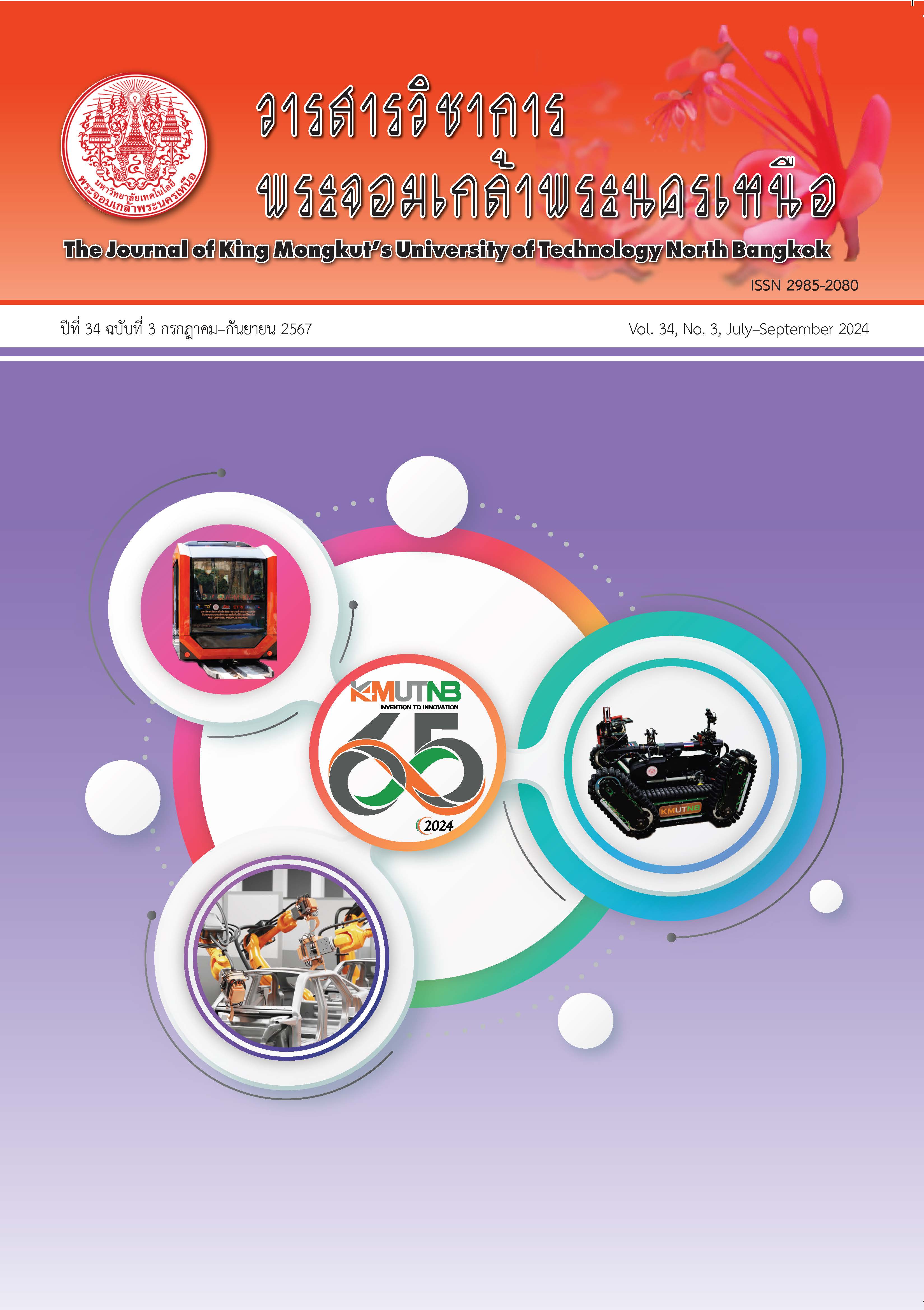ผลของปริมาณความชื้นในไม้ยางพาราที่ผ่านการอบด้วยความร้อนสูงที่มีต่อประสิทธิภาพของคานไม้ประสานด้วยกาวภายใต้น้ำหนักบรรทุกแบบคงค้างและแบบสลับทิศ
Main Article Content
บทคัดย่อ
งานวิจัยนี้เน้นไปที่การศึกษาผลของความชื้นในไม้ยางพาราที่ผ่านการปรับปรุงสมบัติด้วยความร้อนสูงที่มีผลต่อสมบัติในการรับแรงดัด พฤติกรรมการคืบดัด และการให้น้ำหนักบรรทุกแบบสลับทิศของคานไม้ประสานด้วยกาว รวมทั้งนำเสนอผลการทดสอบในห้องปฏิบัติการของคานไม้ยางพาราประสานด้วยกาวที่มีความชื้นในไม้ร้อยละ 7.73 และ 6.26 หลังจากผ่านการอบด้วยความร้อนสูงที่เปรียบเทียบกับคานไม้ยางพาราควบคุมประสานด้วยกาวที่ไม่ได้ผ่านการปรับปรุงด้วยความร้อนสูงซึ่งจะมีปริมาณความชื้นในไม้ร้อยละ 9.66 ในกรณีของสมบัติในการรับแรงดัด กำลังต้านทานแรงดัดสูงสุดของคานไม้ยางพาราประสานด้วยกาวที่มีปริมาณความชื้นในไม้ร้อยละ 7.73 และ 6.26 หรือลดลงจากไม้ยางพาราควบคุมร้อยละ 19.98 และ 35.20 มีค่าลดลงอย่างเห็นได้ชัดร้อยละ 8.57 และ 46.72 ตามลำดับ ในขณะที่ค่าโมดูลัสความยืดหยุ่นมีการเปลี่ยนแปลงน้อยมาก สำหรับผลการทดสอบการให้น้ำหนักบรรทุกแบบคงค้างโดยพิจารณาคานไม้ยางพาราประสานด้วยกาวที่มีความชื้นในเนื้อไม้ที่แตกต่างกันและแปรเปลี่ยนระดับความเค้นคงค้างเป็นเวลา 1,000 ชั่วโมง พบว่าค่าการคืบสัมพัทธ์สูงสุดเท่ากับ 0.31 ซึ่งมีค่าน้อยกว่าไม้ท่อนตันที่ไม่ได้ทำการประสานด้วยกาว อย่างไรก็ตามค่าการคืบสัมพัทธ์ของคานไม้ยางพาราประสานด้วยกาวที่มีปริมาณความชื้นร้อยละ 7.73 และ 6.26 ที่ระดับความเค้นร้อยละ 55 มีค่าลดลงอย่างมากเหลือเพียงร้อยละ 47.27 และ 42.27 ตามลำดับ การทดสอบแสดงให้เห็นว่าการเปลี่ยนแปลงความชื้นในเนื้อไม้ส่งผลโดยตรงต่อค่าความคืบสัมพัทธ์โดยเฉพาะที่ระดับความเค้นที่สูง การทดสอบการให้น้ำหนักบรรทุกแบบคงค้างเป็นระยะเวลายาวนานขึ้นที่ 1 ปี พบว่าสมการตามกฎยกกำลังซึ่งใช้ทำนายการคืบระยะสั้นที่ 1,000 ชั่วโมง ยังสามารถใช้ทำนายพฤติกรรมการคืบดัดของไม้ยางพาราประสานด้วยกาวในระยะยาวได้ด้วย ในกรณีของการให้แรงแบบสลับทิศผลการทดสอบชี้ให้เห็นว่าคานไม้ประสานด้วยกาวที่มีปริมาณความชื้นร้อยละ 7.73 และ 6.26 เมื่อเทียบกับคานไม้ยางพาราควบคุม มีค่าการสลายพลังงานลดลงเฉลี่ยร้อยละ 21.05 และ 82.51 ตามลำดับ แสดงให้เห็นว่าการลดลงของความชื้นในไม้มีผลต่อค่าการสลายพลังงานและค่าการเสื่อมถอยกำลังของคานไม้ยางพาราประสานด้วยกาว การศึกษาครั้งนี้ยังชี้ให้เห็นว่าปริมาณความชื้นร้อยละ 7.73 หลังจากปรับปรุงสมบัติด้วยความร้อนสูงเป็นปริมาณความชื้นที่เหมาะสมในการนำไปใช้เป็นชิ้นส่วนของโครงสร้าง เนื่องจากส่งผลต่อการลดลงของสมบัติบัติเชิงกลไม่มากนักแต่ให้ผลดีในแง่ของการคงขนาดและการทนทานต่อสภาพแวดล้อม
Article Details

อนุญาตภายใต้เงื่อนไข Creative Commons Attribution-NonCommercial-NoDerivatives 4.0 International License.
บทความที่ลงตีพิมพ์เป็นข้อคิดเห็นของผู้เขียนเท่านั้น
ผู้เขียนจะต้องเป็นผู้รับผิดชอบต่อผลทางกฎหมายใดๆ ที่อาจเกิดขึ้นจากบทความนั้น
เอกสารอ้างอิง
W. Boonsong, “A development of c-grade processed rubberwood of aaa co., ltd.,” M.S. thesis, Graduate School of Commerce Burapha University, Burapha University, 2017 (in Thai).
L. Todaro, A. Rita, P. Cetera, and M.D. Auria, “Thermal treatment modifies the calorific value and ash content in some wood species,” Fuel, vol. 140, pp. 1–3, 2015.
D. Sandberg and A. Kutnar, “Thermally modified timber: Recent developments in Europe and North America,” Wood and Fiber Science, vol. 48, no. 1, pp. 28–39, 2016.
B. F. A. Bakar, S. Hiziroglu, and P. M. Tahir, “Properties of some thermally modified wood species,” Materials and Design, vol. 43, pp. 348–355, 2013.
P. H. G. Cademartori, P. S. B. Santos, L. Serrano, J. Labidi, and D. A. Gatto, “Effect of thermal treatment on physicochemical properties of gympie messmate wood,” Industrial Crops and Products, vol. 45, pp. 360–366, 2013.
E. D. Tomak, D. Ustaomer, M. A. Ermeydan, and S. Yildiz, “An investigation of surface properties of thermally modified wood during natural weathering for 48 months,” Measurement, vol. 127, pp. 187–197, 2018.
Y. Nadir and P. Nagarajan, “The behavior of horizontally glued laminated beams using rubber wood,” Construction and Building Materials, vol. 55, pp. 398–405, 2014.
W. H. W. Mohamad, M. A. Razlan, and Z. Ahmad, “Bending strength properties of glued laminated timber from selected Malaysian hardwood timber,” International Journal of Civil & Environmental Engineering, vol. 11, no. 4, pp. 7–12, 2011.
C. Bengtsson, “Mechano-sorptive creep of timber-influence of material parameters,” Holz als Roh- und Werkstoff, vol. 59, pp. 229–236, 2001.
W. Zhang, M. Tokumoto, and T. Takeda, “Effects of temperature on mechano-sorptive creep of delignified wood,” Journal of Wood Science, vol. 53, pp. 187–191, 2007.
C. O. Ceallaigh, K. Sikora, D. McPolin, and A. M. Harte, “The mechano-sorptive creep behaviour of basalt FRP reinforced timber elements in a variable climate,” Engineering Structures, vol. 200, 2019.
T. Li, D. Cheng, A. Stavros, M. E. P. Wålinder, and D. Zhou, “Response of hygroscopicity to heat treatment and its relation to durability of thermally modified wood,” Construction and Building Materials, vol. 144, pp. 671–676, 2017.
Standard Test Methods for Direct Moisture Content Measurement of Wood and Woodbased Materials, ASTM D4442-16, ASTM International, West Conshohocken, PA., United States of America, 2016.
Standard Test Methods of Static Tests of Lumber in Structural Sizes, ASTM D198-14, 2014.
Standard Specification for Evaluation of Duration of Load and Creep Effects of Wood and Wood-based Products , ASTM D6815-09, 2015.
Timber Structures-test Methods-cyclic Testing of Joints Made with Mechanical Fasteners, EN 12512, 2005.
R. W. Bailey, “The utilization of creep test data in engineering design,” Proceedings of the Institution of Mechanical Engineers Transport Engineering, vol. 131, pp. 131–349, 1935.
F. H. Norton, The Creep of Steel at High Temperature. McGraw-Hill, New York, NY. pp. 67–70, 1929.
T. Pulngern, T. Chitsamran, S. Chucheepsakul, V. Rosarpitak, S. Patcharaphun, and N. Sombatsompop “Effect of temperature on mechanical properties and creep responses for wood/PVC composites,” Construction and Building Materials, vol. 111, pp. 191–198, 2016.
T. Pulngern, K. Chanto, W. Pansuwan, and W. Pattaraumpornsak, “Effect of lamina thickness on flexural performance and creep behavior of douglas fir glued laminated timber beam,” Wood Research, vol. 65, no. 5, pp. 715–726, 2020.
M. A. A. Alrubaie, R. A. Lopez-Anido, and D. J. Gardner, “Flexural creep behavior of highdensity polyethylene lumber and wood plastic composite lumber made from thermally modified wood,” Polymer, vol. 12, no. 2, pp. 262, 2020.
M. Sehlstedt-Persson, “Properties of solid wood: Responses to drying and heat treatment,” Licentiate thesis, Department of Skellefteå Campus, Division of Wood Science and Technology Luleå University of Technology, 2005.
S. Gowda, M. Kortesmaa, and A. Ranta-Maunus, “Long term creep tests on timber beams in heated and non-heated environments,” Technical Research Centre of Finland, Espoo, Finland, VTT Publication 278, 1996.
C. C. Gerhards, “Bending creep and load duration of douglas-fir 2 by 4s under constant load for up to 12-plus years,” Wood Fiber Science, vol. 32, no. 4, pp. 489–501, 2000.
H. Epmeier, M. Johansson, R. Kliger, and M. Westin, “Bending creep performance of modified timber,” Holz als Roh- und Werkstoff, vol. 65, pp. 343–351, 2007.
Y. Shen and R. Gupta, “Evaluation of creep behavior of lumber,” Forest Products Journal, vol. 47, pp. 89–96, 1997.
R. Edward, S. Elzbieta, M. Jerzy, M. Przemysław, and B. Magdalena, “Moisture-dependent strength properties of thermally-modified Fraxinus excelsior wood in compression,” Materials, vol. 13, 1647.
A. Ataei, A.A. Chiniforush, M. Bradford, and H. Valipour, “Cyclic behavior of bolt and screw shear connectors in steel-timber composite (STC) beams,” Journal of Constructional Steel Research, vol.161, pp. 328–340, 2019.

